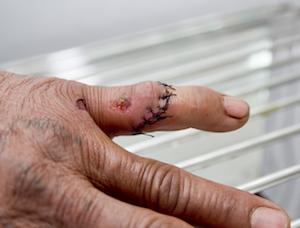Traumatic Amputations
What is a Traumatic Amputation?
A traumatic amputation is the removal of a limb or appendage that occurs as the result of an accident or injury. An amputation can range from the loss of a single toe or finger all the way to the entire leg or arm. Nearly 1.2 million individuals in the United States are living with an amputation. In the United States, about 22 percent of amputations are due to trauma and 70 percent of these amputations involve the upper limbs. Traumatic amputations are some of the most serious and debilitating injuries an individual can suffer. It is crucial to seek immediate medical attention for traumatic amputations, as they can be life threatening and the long-term outcome for an amputee depends on early emergency and critical care management.
How Does a Traumatic Amputation Occur?

Traumatic amputations usually result from factory, farm, power tool accidents, workplace accidents, or motor vehicle accidents. In the workplace, traumatic amputations occur most often when individuals operate unguarded or inadequately safeguarded machinery such as power presses, band saws, milling machines, food slicers, etc.
What is an amputation settlement worth?
The settlement value of an amputation injury case may be difficult to determine before reviewing medical evidence, such as medical records and bills, and having a clear understanding of the theory of liability. The value of amputation injuries can vary from case to case, depending on the location of the amputation, the severity of injury, and the treatment provided. Generally, damages for past and future pain and suffering, loss of a normal life, past and future medical bills, and wage loss can be obtained in an amputation injury settlement. However, an amputation settlement can be diminished based on whether a plaintiff’s own negligence (or “comparative fault”) contributed to the injury.
What are the Symptoms of an Amputation?
Symptoms can vary depending on the severity and location of the amputation, however, symptoms likely to be present include:
- Bleeding (may be minimal or severe, depending on the location and nature of the injury)
- Pain (this will vary greatly)
- Crushed, torn, and/or severed body tissue (the amputated limb or appendage could be badly mangled, but still partially attached by muscle, bone, tendon, or skin)
Types of Amputations
Traumatic amputations can be categorized as complete or partial amputations. In a complete amputation, the limb or appendage is completely severed. In a partial amputation, some soft-tissue connection remains (the limb or appendage is partially attached by muscle, tendon, skin, etc.). Furthermore, the term “disarticulation” can be used to describe an amputation more precisely between joint surfaces (e.g., a traumatic amputation of the lower arm at the elbow joint, opposed to amputation occurring somewhere along the forearm, would be described as an elbow disarticulation).
Treatments for Amputations
Treatments for traumatic amputations will vary depending on the severity and location of the amputation. Surgery will be required to close the wound. Wound closure is typically achieved by rearranging the skin around the wound; however, it may be necessary to use skin, muscle, or tendons from another part of your body to cover the wound. Surgery may involve shaping the wound area to be able to fit a prosthesis as well. Occasionally, a traumatically amputated limb or appendage may be reattached. However, in many cases, reattachment of the amputated limb or appendage is not possible or advisable due to risk of the reattached part being chronically painful, stiff, and/or have an abnormal or absent feeling. Traumatic amputations can cause permanent disability and participation in a rehabilitation program post-surgery will likely be necessary to help regain function and address pain and abnormal sensation. Rehabilitation will likely include exercises that promote muscle strength, improve range of motion or flexibility, improve motor skills, and restore the ability to perform activities of daily living.
To ensure the best possible outcome, immediate medical intervention is necessary when treating traumatic amputations. The following steps should be taken while waiting for medical help to arrive:
- Control the bleeding by applying direct pressure to the wound. Raising the injured area above the heart can help reduce bleeding as well (e.g., holding your hand over your head if you have severed a finger).
- Remove any dirty material that can contaminate the wound. Then gently rinse the wound with clean water if it is dirty.
- Wrap the severed body part in a clean, damp cloth, place it in a sealed plastic bag and place the bag in an ice water bath.
- If cold water is not available, then try keeping the severed body part away from heat as much as possible. Keeping the severed body part cool will increase the probability of reattachment at a later time. Without cooling, the severed part is only viable for reattachment for about 4 to 6 hours.
- Lay down flat and raise your legs about 12 inches. This can help prevent shock if there is a severe amount of blood loss.
Contact the Illinois Personal Injury Lawyers at The Law Offices of John J. Malm & Associates
The knowledgeable Illinois injury attorneys at John J. Malm & Associates have successfully handled complicated cases for our clients who have suffered traumatic amputations in car accidents, semi-truck accidents, work accidents, and as a result of defective products. We are a team of experienced personal injury lawyers who represent individuals and families who have suffered an injury or loss due to an accident in Naperville, St. Charles, and throughout Illinois. You may be entitled to a substantial settlement if you have been injured. Call 630-527-4177, or 630-524-2323, and speak with Attorney John J. Malm and his team today.








